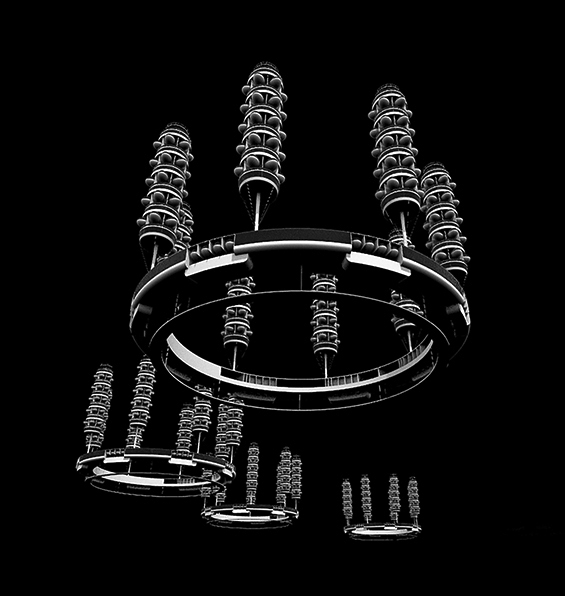Vkhutemas Exhibition Receives Grant Awards
POSTED ON: August 26, 2021

View of the Core Division Report Exhibition of student projects (exercises from the Color and Space courses) at Vkhutemas-Vkhutein, 1928. Courtesy Richard Saltoun Collection, London.
The Irwin S. Chanin School of Architecture is pleased to announce that its upcoming exhibition Vkhutemas: Laboratory of the Avant-Garde, 1920–1930 has received generous support from both the New York State Council on the Arts and the Graham Foundation for Advanced Studies in the Fine Arts.
Curated by Anna Bokov, Assistant Professor Adjunct, and Steven Hillyer, Director of the Architecture Archive, the exhibition integrates Bokov’s scholarship for her recent publication Avant-Garde as Method: Vkhutemas and the Pedagogy of Space, 1920–1930 (Park Books, 2020) and her teaching at The Cooper Union.
Active in Moscow in the 1920s, the Higher Art and Technical Studios, known as Vkhutemas, translated radical experiments in art, architecture, and design into a systematized body of knowledge. This educational undertaking of unprecedented scale and complexity served as one of the major platforms for institutionalizing the avant-garde movement. Vkhutemas: Laboratory of the Avant-Garde, 1920–1930 examines this interdisciplinary design school through the lens of an ideological campaign for mass education and traces the development of a new pedagogical model based on the school’s “objective method”—a standardized, universally applicable approach to design education.

“Our commitment to teaching goes beyond the education of young architects; at The Cooper Union, we interrogate the very pedagogies that form our foundations,” said Dean Nader Tehrani. “As we revisit some of the experiments of the 20th century, Vkhutemas stands out as one of those critical historical moments when canons were overthrown and rethought. For this reason, it becomes all the more important an example as we re-examine our foundations today by better understanding the ideological underpinnings that give rise to what we tend to naturalize. It gives me great pleasure to have this research be part of our dialogue with history today.”
Although Vkhutemas is often referred to as the Russian Bauhaus, the two schools had substantially different futures. While much attention has been given to the Bauhaus, Vkhutemas fell into obscurity for nearly a century. This exhibition commemorates the school’s decade-long existence and seeks to rediscover its vast creative legacy within the history of Modernism. As there are no surviving physical models from the school, and very few remaining three-dimensional artifacts, this project will make a significant contribution to Vkhutemas scholarship by drawing from Bokov’s extensive archival research in the U.S. and abroad, and by working with Cooper Union students to analyze and reconstruct key examples of the school’s exercises and projects.

For the past two years Bokov has conducted a spring semester Vkhutemas seminar in which students are introduced to the school’s pedagogy and prompted to research and recreate, in three-dimensions, seminal educational tools and student projects that emerged nearly a century ago from the curriculum. Work produced in these seminars, including studio assignments, project briefs, explanatory diagrams, and reconstructed projects, will be included in the exhibition.
“Vkhutemas was the first school to venture into teaching modern architecture on a mass scale starting in 1920,” said Anna Bokov. “The question, of course, was how to teach something that was in its nascent phase, something that you don’t yet know. As such, Vkhutemas was not simply a school but a laboratory—an educational condenser—where radical social ideas were forged as new spatial forms. At Cooper Union we have followed a historical trajectory of this groundbreaking pedagogy, from foundational exercises to architectural projects and scientific experiments, by documenting, analyzing, modeling, and in many cases, reconstructing the design intent behind them.”

As a result, the exhibition will be the first to explore Vkhutemas both through comprehensive archival material and a curated selection of newly produced three-dimensional reconstructions and analytical charts. The intent is not just to focus on the approaches of individual students and faculty, but to highlight the collective aspects of this remarkable creative experiment and its educational model.
“I am really excited this exhibition will take place at The Cooper Union,” noted Steven Hillyer. “Our students and faculty—and the greater architecture community of New York—will benefit greatly from learning about this important, often overlooked pedagogy. It’s also a critical moment for the students who participated in Anna’s seminars on the subject and will see their analytical investigations come to light as part of this innovative, research-driven exhibition. We are grateful to the Graham Foundation and NYSCA for generously supporting this effort.”
The exhibition will be held in the Arthur A. Houghton Jr. Gallery from January 18 – February 24, 2023.




